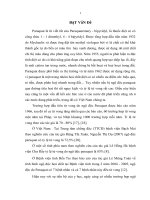- Trang chủ >>
- Khoa học tự nhiên >>
- Vật lý
Bước đầu đánh giá kết quả phương pháp nuôi dưỡng trẻ sinh non nhẹ cân bằng cho ăn sớm tại trung tâm chăm sóc và điều trị sơ sinh Bệnh viện Phụ Sản TW 2017_Tiếng Anh
Bạn đang xem bản rút gọn của tài liệu. Xem và tải ngay bản đầy đủ của tài liệu tại đây (337.08 KB, 28 trang )
<span class='text_page_counter'>(1)</span><div class='page_container' data-page=1>
<b>BÁO CÁO HỘI NGHỊ SẢN PHỤ KHOA VIỆT PHÁP 2018 </b>
<b>PRELIMINARY EVALUATION OF THE RESULTS OF </b>
<b>EARLY FEEDING LOW BIRTH WEIGHT PRETERM BABY </b>
<b>AT CENTRE FOR NEONATAL CARE IN NATIONAL </b>
<b>HOSPITAL OF OBSTETRICS AND GYNECOLOGY 2017</b>
Specialist of Midwife Nguyen Thanh Thuy
MHM. Nguyen Thị Thanh Tam
</div>
<span class='text_page_counter'>(2)</span><div class='page_container' data-page=2>
<b>CONTENTS </b>
1.
Motivations
2.
Research Objectives
3.
Background
4.
Research Methods
5.
Results and Discussion
6.
Conclusions
</div>
<span class='text_page_counter'>(3)</span><div class='page_container' data-page=3>
<b>MOTIVATIONS</b>
<i><b>Benefits of proper feeding for preterm infants: </b></i>
•<i>Shorten recovery time at birth </i>
•<i>Improve nutritional intake </i>
•<i>Reduce perinatal time </i>
•<i>Stimulates digestive system </i>
•<i>Reduce the frequency of cholestasis </i>
•<i>Reduced treatment time </i>
<i>Premature infants Mortality contributes to one third neonatal Mortality</i>
<i>Respiratory: pneumonia, </i>
<i> respiratory arrest </i>
<i>Brain: bleeding brain, </i>
<i> brain barrier </i>
<i>Metabolic: lower temperature, </i>
<i> hypoglycaemia, jaundice … </i>
<i>Other complications: </i>
<i> retinal disease, infection </i>
<i>Cardiovascular: </i>
<i>the tube artery… </i>
<i>Gastrointestinal: </i>
<i>poor feeding </i>
<i>COMPLICATIONS </i>
</div>
<span class='text_page_counter'>(4)</span><div class='page_container' data-page=4>
R. Kishore Kumar et al (2017)
- Enteral feeding is safe and may be preferred to parenteral nutrition due to
the complications associated with the latter
- Early, fast, or continuous enteral feeding yields better outcomes compared
to late, slow, or intermittent feeding, respectively
- Preterm infants can be fed while on ventilator or continuous positive airway
pressure
- EBM is the first choice for feeding preterm infants due to its beneficial effects
on cardiovascular, neurological, bone health, and growth outcomes; the
second choice is donor pasteurized human milk
- Standard fortification is effective and safe
- Optimizing weight gain in preterm infants prevents long-term cardiovascular
complications
</div>
<span class='text_page_counter'>(5)</span><div class='page_container' data-page=5>
<i><b>Related weight gain: </b></i>
• Time to start feeding sooner
• Shorten the duration of parenteral feeding
• Early enternal feeding
Nutritional approach to preterm infants on non invasive ventilation:
Nutrition (2017)
</div>
<span class='text_page_counter'>(6)</span><div class='page_container' data-page=6>
<i><b>At NHOG: </b></i>
• Early feeding for low weight preterm infants has been
apployed at the Center of Neonatal Care from January
2017.
• There isn’t any researchs on this method in NHOG
</div>
<span class='text_page_counter'>(7)</span><div class='page_container' data-page=7>
<b>Preliminary evaluation of the results of early feeding </b>
<b>low birth weight preterm baby at Centre for neonatal Care </b>
</div>
<span class='text_page_counter'>(8)</span><div class='page_container' data-page=8>
Preliminary evaluation of the results of early
feeding low birth weight preterm baby at
Centre for neonatal Care in national
Hospital of Obstetrics and Gynecology 2017
</div>
<span class='text_page_counter'>(9)</span><div class='page_container' data-page=9>
<b> </b>
<b>BACKGROUND </b>
<b>Nursing diagnosis of </b>
<b>LBW preterm babies </b>
Respiratory
depression
Jaundice
Infections
Dermatitis,
navel
inflammation,
conjunctivitis
Loss weight
</div>
<span class='text_page_counter'>(10)</span><div class='page_container' data-page=10>
• Increasingly important and contributing to the success of
medical treatment in general and care for preterm babies in
particular.
• Reasonable nutrition, science will help premature babies
quickly catch up to growth momentum to grow like full-term
babies.
• However, the practice of comprehensive nutrition measures
has not been properly addressed
<i><b>The role of nutrition </b></i>
</div>
<span class='text_page_counter'>(11)</span><div class='page_container' data-page=11>
<b>Nutrition for low birth weight preterm baby</b>
Nutrition for
LBW
preterm
babies
Intravenous
feeding
Feeding by
mouth and
breastfeeding
Umbilical
</div>
<span class='text_page_counter'>(12)</span><div class='page_container' data-page=12>
• 124 LBW preterm babies (<32w, BW <1500g) in NICU
(1/2015 - 6/2016)
• 36,5% slow growth after birth
• Need optimal nutrition
Sumru Kavurt & Kıymet Celik, The Journal of Maternal-Fetal &
Neonatal Medicine 2017
</div>
<span class='text_page_counter'>(13)</span><div class='page_container' data-page=13>
• AAP and ESPGHAN<b>: </b>nutritional support is optimal for preterm infants to
achieve near normal developmental at gestational age.
• Intestinal nutrition for optimum growth in preterm infants (Myo-Jing Kim,
2016): Achieving the best growth for preterm infants requires "positive
nutrition" and adequate intestinal nutrition. Minimal intestinal nutrition
should be started as soon as possible after birth, and progress in feeding
should be based on the clinical course of each newborn.
</div>
<span class='text_page_counter'>(14)</span><div class='page_container' data-page=14></div>
<span class='text_page_counter'>(15)</span><div class='page_container' data-page=15>
<b>OBJECTIVES, DESIGNS, TIMES, PLACES </b>
•
<b>Objectives: </b> Selection criteria:
• Preterm babies at the Neonatal Care and Treatment Center
• Weight ≤ 1000gram
• No defects, deformities, pathology (intestinal obstruction, ...)
• Be fed according to the procedure for preterm infants, light
weight to eat early in Center for neonatal care.
</div>
<span class='text_page_counter'>(16)</span><div class='page_container' data-page=16>
<i>- </i>
)
2
1
(
•
<b>Study design: </b>Non-control interventions•
<b>Time: </b>January to December 2017•
<b>Place: </b> Neonatal Center for Immunization and NeonatalCare
•
<b>Sample size: </b> Sample all full-term preterm birth weightbabies at the Neonatal Care and Treatment Center from
January to September 2017. So we have a sample size of
452 children.
</div>
<span class='text_page_counter'>(17)</span><div class='page_container' data-page=17>
<b>SL Collection Tool: </b>Evaluation of nursing performance of
preterm infants weighed by early feeding method at
Neonatal Care and Treatment Center
<b>Data analysis: </b>
• Input: Data was encoded and entered using Epidata 3.1
software,
• Analyzed by SPSS 16.0 software
</div>
<span class='text_page_counter'>(18)</span><div class='page_container' data-page=18>
<b>RESEARCH VARIABLE </b>
<b>Variable group: </b>
Genaral Information:
• Demographic characteristics of the mother
• neonatal characteristics: gestational age, weight, sex, method of delivery,
early feeding
Information on feeding efficiency of preterm infants by early feeding
method:
• Die in hospital: die within the first 24 hours, live within 25h-72h, live 3-7
days, live 8-14 days, live 15-30 day, live 31-45 days, live 46-60 days, live
more than 60 days.
</div>
<span class='text_page_counter'>(19)</span><div class='page_container' data-page=19></div>
<span class='text_page_counter'>(20)</span><div class='page_container' data-page=20>
<b>Informations </b> Frequency <b>Rate (%)</b>
<b>Sex </b>male
female
251
201
55,6
44,4
<b>Baby order </b>1st baby
Un from 2nd baby
222
230
49,2
50,8
<b>Pregnancy week </b>21 - 25 weeks
25 weeks 1 day - 28 weeks
28 weeks 1 day - 32 weeks
32 weeks 1 day - 35 weeks
over 35 weeks
143
174
109
19
7
31,6
38,5
24,1
4,2
1,6
<b>Birth weight (gram) </b>< 500
500-700
701-900
901-1000
9
259
107
77
2,0
57,3
23,7
17,0
<b>Way give birth </b>Normal Birth
Caesarean
317
135
60,1
29,9
</div>
<span class='text_page_counter'>(21)</span><div class='page_container' data-page=21>
<b>Chart 1. Survival rate of stage discharge 2015-2017 </b>
21
79
23.3
76.7
26.6
73.4
0
10
20
30
40
50
60
70
80
2015 2016 2017
</div>
<span class='text_page_counter'>(22)</span><div class='page_container' data-page=22>
<b>Birth </b>
<b>weight</b> <b>Total</b>
<b>Live ≤ </b>
<b>24h</b>
<b>Live </b>
<b>25-72h</b>
<b>Live </b>
<b>73h-7 </b>
<b>days</b>
<b>Live 8 - </b>
<b>14 days</b>
<b>Live </b>
<b>15-30 days</b>
<b>Live </b>
<b>31-45 days</b>
<b>Live </b>
<b>46-60 days</b>
<b>Live </b>
<b>over 60 </b>
<b>days</b>
<b>Live and </b>
<b>discharge</b>
<500g
9 (2,0%)
9 0 0 0 0 0 0 0 0 (0%)
500-700g
259
(57,3%)
157 7 2 15 14 0 0 0
64
(24,7%)
701-900g
107
(23,7%)
8 2 0 30 35 0 0 0
32
(29,9%)
901-1000g
77 (17,0%)
7 0 0 18 28 0 0 0
24
(31,2%)
Tổng
452
(100%)
181 9 2 63 77 0 0 0
120
(26,6%)
</div>
<span class='text_page_counter'>(23)</span><div class='page_container' data-page=23>
<b>Living time</b> <b>21 - 25 weeks</b> <b>25 weeks 1 day </b>
<b>- 28 weeks</b>
<b>28 weeks 1 day </b>
<b>- 32 weeks</b>
<b>32 weeks 1 day </b>
<b>– 35 weeks</b> <b>over 35 weeks</b>
≤ 24h 113 55 6 0 7
25-72h 0 9 0 0 0
73h-7 days 0 0 2 0 0
8-14 days 2 18 43 0 0
15-30 days 12 21 30 14 0
31-45 days 0 0 0 0 0
46-60 days 0 0 0 0 0
> 60 days 0 0 0 0 0
living and discharge. <sub>4 </sub> <sub>43 </sub> <sub>47 </sub> <sub>23 </sub> <sub>3 </sub>
<b>Total</b> <b>131</b> <b>146</b> <b>128</b> <b>37</b> <b>10</b>
</div>
<span class='text_page_counter'>(24)</span><div class='page_container' data-page=24></div>
<span class='text_page_counter'>(25)</span><div class='page_container' data-page=25></div>
<span class='text_page_counter'>(26)</span><div class='page_container' data-page=26>
<b>CONCLUSIONS </b>
•
The rate of hospital discharge was 26.6%•
Children are raised on good weight, have good reflexfeeding, get to mother, accounting for 24.7%
•
Children weighing 500-700g, 701-900g, 901-1000gincreased survival rate, 24.7% respectively; 29.9%; 31.2%;
the rate of vomiting is 13.2%
</div>
<span class='text_page_counter'>(27)</span><div class='page_container' data-page=27>
<b>RECOMMENDATIONS </b>
<b>For infant’s family </b>
• Encourage the mother to have a diet, drink, sleep, reasonable rest to
have milk for children to eat early.
<b>For NHOG </b>
• Continue to implement this method in the Center for neonatal care
• Transfer this method to lower-level hospitals, reduce the load for
top-level hospitals, thus raising the effectiveness of treatment and
feeding of preterm and low-birth-weight infants at provincial and
district levels.
</div>
<span class='text_page_counter'>(28)</span><div class='page_container' data-page=28></div>
<!--links-->
Nghiên cứu phương pháp phẫu thuật và bước đầu đánh giá kết quả của phẫu thuật bảo tồn trong điều trị ung thư vú nữ tại bệnh viện k
- 35
- 862
- 3








